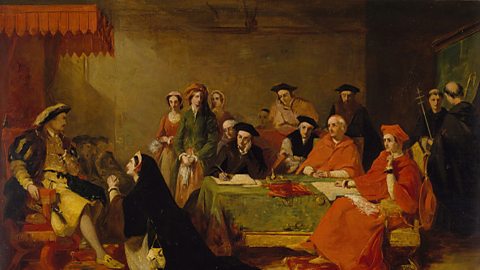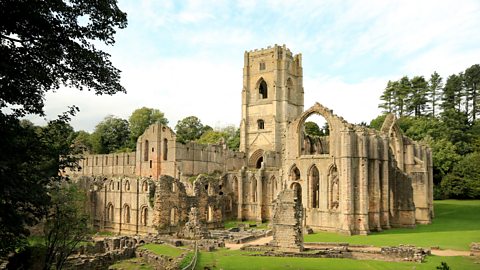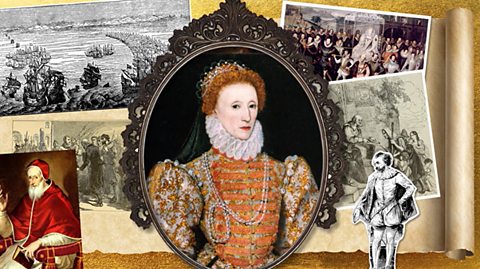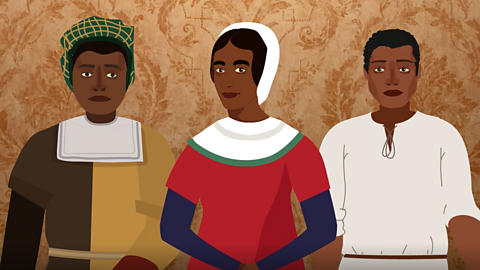Key points
- Henry VIII had been a devout Catholic in his younger years. He had defended the Pope against the Protestant ideas published by Martin Luther, a German priest.
- In 1534, Henry declared that he, not the Pope, was the head of the Church in England. This sparked the English ReformationThe Reformation (1533 – 1603) is the name given to the reform (changing) of the Church during the Tudor period..
- The break with Rome eventually triggered England’s transition to being a Protestant country.
- The Reformation had major repercussions, including the Dissolution of the Monasteries and many rebellions.
Video about the Reformation
Narrator:
Henry VIII was brought up as a devout Catholic. In the early years of his reign he attended mass five times a day and his most trusted adviser was the head of the Catholic Church in England, Cardinal Wolsey. So what caused Henry to break from the Catholic Church and its leader in Rome, the Pope?
Henry and his first wife, Catherine of Aragon, had a daughter, Mary, but Henry wanted a son, a male heir to the throne. Henry had also fallen in love with Anne Boleyn. The Catholic Church would not allow Henry to divorce Catherine, so in 1527, he asked the Pope to annul the marriage instead. The Pope refused and Henry decided to make himself Head of the Church of England so he could marry Anne.
Another reason Henry wanted to break from the Pope was that the Catholic Church was very rich. By taking control of church properties, Henry would gain vast amounts of wealth that would help fund his wars with France, Scotland and Ireland. He and his new chief adviser, Thomas Cromwell, began the Dissolution of the Monasteries. Religious buildings were destroyed, and the land and wealth was transferred to the king.
Over four years, 800 monasteries were disbanded and their lands and treasures were taken by the Crown. At the same time, across Europe, a new religious belief system was emerging: Protestantism, led by people like John Calvin and Martin Luther. The Protestant religion rejected the Pope's control and wanted individual believers to have their own relationship with God rather than only through a priest.
These events came after many years of people calling for change within the Church. Even Anne Boleyn, who would become Henry's wife, was in favour of some church reform. The break with Rome opened the door for Protestantism to grow in the country.
This period is known as the English Reformation. Religious discrimination grew on both sides and after the reign of Henry VIII, the religion of the king or queen would play a vital role in the shape of the country for centuries to come. However, Henry VIII never became a Protestant.
This suggests his starting of the English Reformation was more about politics, wealth and family dynamics than his personal faith.
Game - Henry and the Catholic Church
Play a History Detectives mission exploring why Henry split from the Catholic Church.
You can also play the full game.
Henry VIII's religious beliefs
For most of his adult life, Henry was a devout CatholicA member of the Catholic Church. Catholics believe in having a hierarchy of priests and bishops beneath the Pope, who is the Head of the Church. Members of the Catholic Church also believe in devotion to the saints and the Virgin Mary, Jesus' mother, and in holding Mass. . He attended daily MassThe central act of worship for Catholics. and went on Catholic pilgrimages to holy sites, such as the shrine to Our Lady of Walsingham, in Norfolk.
In 1517, a German priest and former monk named Martin Luther published a series of criticisms of the Catholic Church. This was the beginning of a new branch of Christianity, which became known as Protestantism, as it began as a protest against the Catholic Church.
Over in England, Henry was shocked and angered by these events. He wrote a book called the Assertio Septem Sacramentorum, or the Defence of the Seven Sacraments, which was a passionate defence of the key aspects of Catholicism. Henry was given a special title of Fidei Defensor, or Defender of the Faith, by the , who was the head of the Catholic Church.
The attempt to get an annulment
In the 1520s, Henry tried to end his first marriage to Catherine of Aragon by seeking an annulmentA way of ending a marriage that is different from a divorce. It could be granted by the Catholic Church, and meant that a marriage never legally existed. . Henry wanted a male heir to his throne, but he and the queen's only surviving child was a daughter, Mary.
To try and keep Henry happy, in June 1529 Pope Clement VII allowed Henry to have his marriage put on trial in England. The Pope allowed a representative called Cardinal Campeggio to come to England. Henry and Catherine gave evidence, with each sharing their different perspective: Catherine wanted to remain married to Henry. Their marriage was discussed by people with a huge amount of knowledge of the law and the Bible. After months of debate and delay, the court did not grant Henry his annulment.

The Pope could not give Henry an annulment for a number of reasons:
- One of Henry's reasons for seeking a divorce was that he thought he had sinned by marrying his brother's widow. However, the biblical book of Deuteronomy states that a man should marry his brother's widow.
- If the Pope declared Henry's marriage invalid, he would first have to go against the papal dispensationThe right of the Pope to exempt someone from the laws of the Church. of a previous Pope, who had allowed Catherine and Henry to wed in the first place.
- Catherine had a powerful Catholic family, who would have objected to the annulment. Her nephew Charles V had swept through Italy with his army after the Battle of Pavia, in 1525. The Pope in Rome was his prisoner.
Activity - the events that led to the break from Rome
Causes of the break from Rome and the start of the Church of England
In 1534, Henry used ParliamentElected members of the House of Commons, and the House of Lords, who helped the King to pass laws. to grant the Act of Supremacy, which allowed him to annul his marriage to Catherine as it made the monarch the head of the English Church. Henry broke with Rome for a range of reasons:
Wanting to end his marriage
After 1529, Henry continued in vain to attempt to get his annulment. However, by 1533 Henry was desperate to find another solution to end his marriage. This contributed to England breaking with the Catholic Church in Rome, and the development of the Church of England.
The influence of Anne Boleyn
In 1526, Henry became romantically interested in one of Catherine of Aragon’s ReformationThe Reformation (1533 – 1603) is the name given to the reform (changing) of the Church during the Tudor period., Anne Boleyn. Anne was an intelligent woman who had encountered reformist ideas, such as those of Martin Luther, during her teenage years in France. Sources from the time suggest that Anne believed in many of these reformist ideas, and she was known to have had a significant influence over Henry. Anne had also said that she would not consummationThe first act of sexual intercourse between two people who are in a relationship or a marriage. her relationship with Henry unless he married her.
The rise of Protestantism
In the years before the break with Rome, groups of people who were attracted to Protestant ideas had begun to gather in England. Networks of men and women met secretly and shared Protestant books, which had been smuggled into England from Europe. With the help of Anne Boleyn, new figures such as Thomas Cromwell and Thomas Cranmer, who had Protestant sympathies, began to rise at court.
Wealth and Power
The power of the Pope was criticised in Protestant texts. In 1531, Henry had Protestant thinkers and university academics compile historical and religious works which showed that a king could make religious decisions in his own kingdom. One such book was called the Collectanea Satis Copiosa, or the Sufficiently Abundant Collections. It argued that Henry should have the power to annul his own marriage in England.
Protestants also criticised the wealth of the Catholic Church. They argued that the clergyReligious leaders in the church such as priests or bishops., monks and nuns did not lead humble lives. Diverting the wealth of the Church from Rome to Henry would help him with his financial issues. Henry always needed money to fund armies, build new castles and expand the Navy.
Ending the marriage to Catherine of Aragon
In 1533, after years of waiting, Henry decided to act. He was confident that he had enough support to break with Rome, and become head of the Church of England.
He had Parliament pass an act that stopped Catherine of Aragon from being able to appeal to the Pope. He then married Anne Boleyn and declared himself the head of the Church of England.
The Treasons Act followed in 1534. Anyone who questioned Henry’s power over the Church, or even thought badly of him, could be punished by death.
Game - Henry's marriages
Play a History Detectives mission exploring whether Henry VIII remarried in order to have a male heir.
The Dissolution of the Monasteries
Anne was executed in 1536, having been charged with treason and several other crimes. However, Protestant men who had risen through the ranks with Anne’s support, such as Thomas Cromwell and Thomas Cranmer, continued to push for religious change.
Like many Protestants, Thomas Cromwell believed that the Church, and in particular the monasteryBuildings lived in by a community of monks who live under religious vows., needed to be reformed. Cromwell sent inspectors up and down the country to visit the nation’s monasteries. These inspectors wrote reports on the wealth of the monasteries, and the lifestyles of their inhabitants. They stated that some monks lived in wealth and luxury, and not in the humble poverty expected of Christian monks. They also claimed that some monasteries had created fake religious relics to bring in money from tourists.
Henry and Cromwell sent men to strip the monasteries of their treasures, and established a new part of the government called the Court of Augmentations. Its job was to organise the selling of the monasteries and their land to noblemen and the gentry. The profits went to the king. It was one of the largest changes of land ownership in English history. Henry gained immense wealth, and his nobles bought up monasteries and their lands, converting them into grand homes.

What did the loss of the monasteries mean for their local communities?
For the communities that relied upon the monasteries, their loss was devastating. Monasteries employed many in the community and provided education, charity and medical care for the poor and vulnerable. They had also dominated the landscape for centuries. Those that weren’t converted into grand houses collapsed into ruins over time.
The impact of the Reformation
- Henry increased Tudor control of Ireland. English monarchs had claimed to be the Lords of Ireland for many years. However, Henry was concerned about rebellions by the Irish, who remained largely Catholic. In 1534 Henry's cousin, 'Silken Thomas' FitzGerald, publicly stated that he was withdrawing his allegiance to the king. This was the beginning of the Kildare Rebellion, which lasted until 1535. Henry was brutal in his response to the rebellion, and had FitzGerald executed in February 1537, along with five of FitzGerald's uncles and 70 leaders of the rebellion. Throughout the rest of the Tudor period, Tudor monarchs tried to take greater control of Ireland.
- The first printed translation of the whole Bible into English was published in 1535. This translation was produced by Miles Coverdale, a Church reformer and bishop. Coverdale used it as the basis of the 'Great Bible', the first 'authorised' translation of the Bible into English, which was published four years later. It was authorised by Henry VIII to be read aloud at Church of England services.
- The Act of the Ten Articles (1536), probably written by Thomas Cranmer, promoted some Protestant ideas and challenged Catholic beliefs. For example, it ignored the Catholic belief in purgatoryIn Catholicism, a place to which people are believed to be sent after they have died if they have not yet confessed and said sorry for all of their sins. Those who are willing to confess their sins will be purified and go to Heaven, while those that have not achieved salvation will be sent to hell. and attacked the traditional Catholic belief in relics as superstition.
- The Lord's PrayerAn important Christian prayer which is, according to the Bible, the way that Jesus taught Christians to pray. In Latin, it is known as the Pater Noster, or 'Our Father'. began to be said in English during services.
Opposition to the Reformation
Before the Reformation, most people in England were Catholic. Their lives centred around the ideas and beliefs of the Catholic Church. This meant that, for many people, Henry’s break with Rome was shocking. This resulted in some opposing the king, even though any defiance was punishable by death under the 1534 Treasons Act.
- Sir Thomas More was a friend of the king. He refused to swear an oath in recognition that Henry was head of the Church, as it conflicted with his Catholic faith. He was later executed.
- Elizabeth Barton was a nun. She had reported experiencing religious visions from the age of 19. Some people believed that these visions might be predictions of the future. Elizabeth claimed that Henry would die quickly if he chose to remarry and break with the Catholic Church. She also said that he would go to hell. For this, she was executed and her head was placed upon London Bridge.
- 18 CarthusianA very strict group of monks within the Catholic Church. monks were executed, after they refused to accept Henry's annulment and new marriage. Furthermore, they rejected his new power as head of the Church of England, and remained loyal to the Pope.
- During the Pilgrimage of Grace, in October 1536, thousands of people from Lincolnshire, Yorkshire, Durham, Northumberland and Westmorland rose up against Henry's new Church of England. They marched under a Catholic banner of the Five Wounds of Christ. Henry's response was brutal: a number of people were executed. The main leader, Robert Aske, was hung in chains in York and left to starve to death slowly.
Long-term impact of the Reformation
Even after Henry’s death in 1547, the effects of the Reformation in England continued to be felt.
Henry’s male heir, Edward VI, was raised by Protestant men such as his uncles, Edward and Thomas Seymour. During his short reign, England became an increasingly devout Protestant. This led to a Catholic rebellion in 1549. Known as the Prayer Book Rebellion, it was led by people who didn’t like Edward’s new Book of Common Prayer, or the changes he was making to the Church.
Under Mary I, daughter of the Catholic Catherine of Aragon, England became a Catholic country once again. Many people who had been keen to keep their Catholic faith during the religious upheaval of the previous years celebrated Mary’s arrival on the throne, throwing bonfires and parties. Protestants, however, were persecuted: around 300 were executed during Mary’s reign. Others fled abroad. As a result of this brutal persecution, Mary earned the nickname of ‘Bloody Mary’.
Under Elizabeth I, daughter of Anne Boleyn, the religion of England changed again. Elizabeth shifted the country towards a more moderate Protestantism using acts of Parliament, which became known as the Religious Settlement. Elizabeth was opposed by Protestants who wanted even further reform, and Catholics who wished for the return to Rome. Elizabeth also had to deal with Catholic rebellions against her rule in both England and Ireland.
After Elizabeth, and into the reigns of King James I (King James VI of Scotland) and beyond, laws were passed which punished and lessened the rights of Catholics across the British Isles. In Ireland, the Catholic community was excluded from having any influence in politics, and they were not allowed to own land.
Henry had sparked a change that would have ongoing and significant implications.
Test your knowledge
Teaching resources
Are you a teacher looking for an interesting way to get your students engaged in history? Challenge your students to see if they would have had what it takes to survive in Tudor England with this KS3 History article.
≥…»ÀøÏ ÷ Teach has thousands of free, curriculum-linked resources to help deliver lessons - all arranged by subject and age group.
Play the History Detectives game! gamePlay the History Detectives game!
Analyse and evaluate evidence to uncover some of history’s burning questions in this game.

More on The Tudors
Find out more by working through a topic
- count3 of 5

- count4 of 5

- count5 of 5

- count1 of 5


